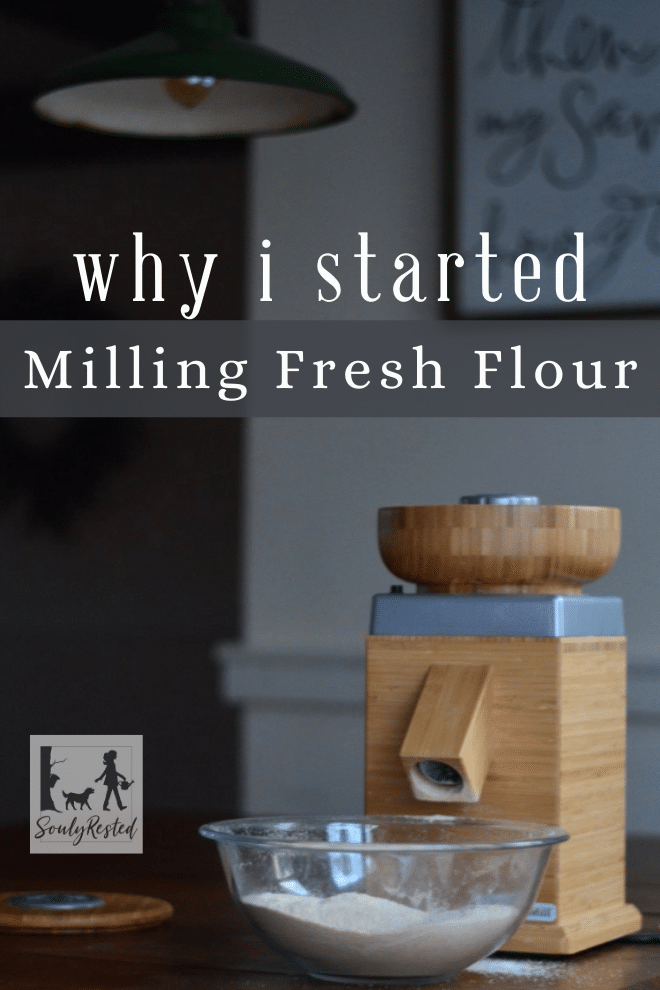Last Updated on August 1, 2025 by Michelle
Bill and I pictured ourselves milling our own flour when we were newlyweds. Then we priced the grains and researched the giant, awkward mill options and realized it was too costly and cumbersome for our small kitchen and smaller budget.
Wow, how things have changed!

Yes, we have a bigger kitchen these days.
But what’s really changed?
- Home grain mills–they’re so much more compact than they used to be, not to mention beautiful, no?
- And wheat berries–they’re readily available, at great prices.
- Today’s mills can grind so many alternative grain options! See all the options my Harvest Mill can grind below.
Why Do I Mill My Own Flour?
I mill my own flour for 4 reasons really:
Nutrition…
Since the wheat berries you use to grind flour at home haven’t been processed yet, the berries retain all of the grain’s vitamins, minerals, and nutrients, which makes fresh flour so much more nutritious for you and your family than commercially-ground flours. Those were ground long before they reached your kitchen, stripped of all the really good-for-your stuff, and then left to sit on a store shelf for months.
Variety…
If your family uses alternative flours, having a grain mill at home can be helpful to grind rye, corn, rice, barley, oats, buckwheat, millet, lentils, and more, which can save tons of money over purchasing non-wheat flours at the store.
Cost…
Milling your own flour can be cheaper than purchasing flour at the store. Obviously, this depends on what kind of wheat you purchase, where you live, and what flour you normally purchase, but for our family, we’ve done the math, and it’s cheaper for us to grind our own flour at home than it is for us to purchase flour at our local supermarket. (See the breakdown of my cost benefit analysis below.)
Taste…
Fresh flour just tastes better. Freshly ground wheat takes on amazing variety of flavor, based on what wheat berries you choose… the flour is a little sweeter, or maybe little nuttier, like the flavor profile of these delicious chocolate chip cookies made with fresh flour… it’s hard to describe, but it’s always a richer flavor when the flour is fresh.

What are Wheat Berries & Why are They Good for You?
Wheat berries are hard kernels of wheat. In each little berry, there are 3 parts:
- the bran (loaded with fiber and nutrients)
- the germ (loaded with oils, vitamins, proteins, and minerals)
- and the endosperm (loaded with starch)
When you purchase flour at the store, the only part of the wheat berry that remains is the endosperm, or lots of starch. That’s it. And that’s why flour companies have to add back in good stuff and call it “enriched.”
The germ and bran parts of the wheat berry are removed from commercial flours because they’re oily and turn rancid quickly, making fresh flour not shelf stable.
But wheat berries? They last (pretty much) forever. And since you’re grinding in the germ and the bran, which flour companies have to strip away, freshly ground flour is a much more nutritious option than even the best flours you can buy.
Added bonus? Wheat berries aren’t just for making fresh flour! If you want some inspiration on ways to cook and eat wheat berries you’ll find that right here.

Bread Making Tips if You’re Milling Your Own Flour
I’m still learning all the ways I want to incorporate fresh milled flour into our kitchen, but here are a few tips I’ve figured out along the way.
- Don’t hesitate to use 1/2 fresh milled and 1/2 commercial flour in your recipes. There is definitely a different texture and that helps keep things more like you’re used to.
- Use about 3 TBs less per cup, compared to commercial flour, because fresh flour absorbs more liquid.
- Try to not add any extra flour as you’re working with your dough. Wet your hands well when working with slightly sticky dough to help it stick less to your hands.
- Avoid over-kneading. Try mixing your ingredients together then walking away for 10 or 20 minutes. Bonus, letting your bread dough sit will make it less sticky when you’ve returned.
- Add vital wheat gluten to your dough if you have trouble with your bread rising. Add 1 TB per 1 cup of flour. (This is where I get my vital wheat gluten.)


Is it Expensive to Mill Your Own Flour?
I was so pleased when I sat down to do a cost-benefit analysis of freshly milled flour versus what I buy in the store. I mean, after all, the healthier option is always more expensive, right? Well this is one instance where I discovered I’m actually saving money by going with the healthiest option.
What I’m saving on flour will eventually pay for my mill!
Here’s how the numbers break down for me:
- When I ordered a bulk bag of wheat berries recently, I paid $23.80 plus $2.02 in shipping for 25 pounds. (See below for my two best sources of wheat berries.) Since 50 pounds of wheat berries doesn’t translate to 50 pounds of flour, I had to do some math.
- Grinding 2 c. of wheat berries yields about 3 1/3 c. of flour for me (there are many variables here though, you may have slightly different results). Grinding the wheat adds air to it and produces more volume. So, in my experience, every 1 cup of wheat berries yields about 1.65 cups of flour.
- Then there are roughly 2 1/2 cups of wheat berries for every 1 pound, so that equates to a little more than 4 cups of flour per pound of wheat berries.
- An average 5 lb. bag of flour from the store contains about 18 cups of flour. So you need about 4.5 pounds of wheat berries to equal a bag of store bought flour.
- I’m paying $0.96 per pound of wheat berries, so I’m spending about $4.32 for 5 pounds of flour.
- King Arthur Whole Wheat flour is currently listed for $5.95/5 lbs. on their website.
So I’m keeping $1.63 in my pocket for every 5 pounds of flour!
Given that a large family can use up to 240 bags of flour in a year, you can save $391.20/year guys!
So my mill was paid off in about 9 months time, and every year thereafter I can save as much $400 while feeding my family the most nutritious flour option!
Now here’s where I’m totally transparent and fess up that I still use a combination of King Arthur flour and fresh milled. So in reality I probably only save a few hundred dollars, but hey, I’ll take it!
That’s a win-win squared, or something like that. 😉
How much fresh flour will 5 pounds of wheat berries make?
The pounds of wheat berries you grind should translate to the same poundage of flour. Although grinding the wheat aerates it and creates much more volume, 5 pounds of wheat berries should make 5 pounds of flour.
In terms of measurement, I’ve found that grinding about half the amount of wheat berries compared to the amount of flour I need does the trick. So if a recipe calls for 2 cups of flour, I’ll need to grind about 1 cup of wheat berries.
Where Do You Get Wheat Berries?
I found the best option for me is Azure Standard. Here’s the wheat berries I use for bread making. And here is a finder to let you know if Azure has a delivery drop near you. (I was elated when they recently expanded their reach into our area of New England.)
But I’ve also ordered a 35-pound bucket of these wheat berries and been very pleased.
If you can find a local farmer who grows and sells wheat berries that would be the best option.
What Alternative Grains Can You Mill at Home?
My Nutrimill Harvest Mill can grind all of these grain options:
hard wheat, soft wheat, spelt, kamut, rye, barley, einkorn, farro, quinoa, millet, amaranth, sorghum, brown rice, wild rice, oat, dried corn, buckwheat, soy beans, lima beans, black beans, pinto beans, lentils, chickpeas, and more.
But each mill has different alternative grains that it can process into flour. Watch here for many alternative grains that I ground into flour in a Mockmill Lino 100.

This article explains lots more, all about alternative grains.
There are many options for grain mills. These are the 3 I recommend: The Classic Nutrimill does a great job, at the lowest price point. The Harvest Mill wins for most beautiful to sit on your counter. And the Mockmill is a beautiful workhorse that wins for best engineered, best at milling alternative grains, and finest flour, but it also sits at the highest price point. Use code SOULYRESTED on nutrimill products to save $$.
Want to make your own freshly-flaked rolled oats? Learn how to flake oats at home here.
I talk about my grain mill, as well as the 11 other kitchen tools I seriously would hate to be without in this episode of my podcast:
Talk to me!
If you have any questions, leave a comment below. And please tag me on ig to inspire me with what you’re baking @souly.rested.
More Fresh Flour Recipes:
Sourdough Bread, Without Wasted Discard
The Secret to a Perfect Giant Cookie
Tortillas Made with Fresh Flour
Chocolate Chip Cookies Made with Fresh Flour
The ultimate guide to wheat berries
Learn All About Fresh Flour in my free e-course
My people shall be satisfied with my goodness, declares the Lord. Jeremiah 31:14
Pin this for later!
Click on the image below to pin this post.
Find out why SoulyRested was considered to be one of the One of the Top Homesteading Blogs.
Glance at my Resource Page if you’d like to get a glimpse of all the supplies I use and recommend for everything from gardening, to homeschooling, to chicken care, to nature journaling, to maple syrup making.
And download my 8-page Pantry Checklist and have instant access to the best ingredients and exclusive discounts.







It seems like the price of wheat berries I am finding are quite a bit more than what you show here in your comparison. Have you noticed a recent increase?
Yes, while I haven’t priced a lot of sources, I have noticed MY source has gone up in price over the past few years… I wonder how much of that is simply the huge demand we’re seeing now for fresh flour… But you’re right, it would be great to do a new price comparison on this article… I’ll try to make time to do that.
I’m sorry but there is some creative accounting going on here: –
“ An average 5 lb. bag of flour from the store contains about 18 cups of flour. So you need about 4.5 pounds of wheat berries to equal a bag of store bought flour.”
Creating 5lb of product from 4.5lb of raw materials? You do contradict this later on stating equal weights, but you’re spoiling a beautiful article with sloppy math.
Hey Mike–thanks for drawing my attention to this. This is a rather old article so I should probably make time to swing back around and double check all the math I did YEARS ago when I knew much less about flour.
Hi Michelle,
Loved reading about all of your wonderful information.